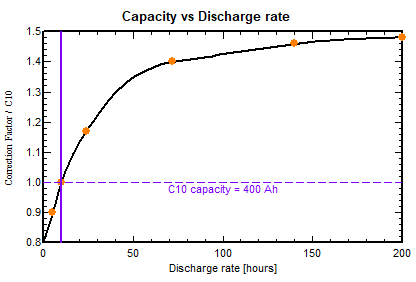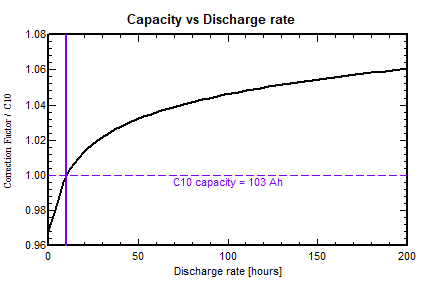Capacity as function of the discharge rate
The capacity is highly varying according to the charge/discharge rate, i.e. the current.
NB: The discharge rate [hours] is the time for fully discharging the battery at a given current. In PVsyst, the nominal capacity is specified at C10, i.e a discharge in 10 hours. This corresponds to a current of 0.1 x capacity, sometimes noted 0.1C.
Lead-acid batteries
The capacity variation is very important: we observe a ratio of about 40 % between C10 and C100 ! In PVsyst, this behavior is defined as a profile.
This will have deep consequences on the battery balance and efficiency when using the battery in a simulation.
Lithium-Ion batteries
The capacity variation is less prononced. The capacity increase at C100 is about 4%.
Peukert model
Here the capacity evolution is obtained by a model. The correction of capacity according to the discharge rate is done through the peukert coefficient K, which is specified in the battery's parameters (usual value K = 1.02):
\(Capacity [Ah] = CapNomC10 * (DischRate / DischRateRef) ^{(1-K)}\)
or
\(Capacity [Ah] = CapNomC10 * (CurrentRef / Current) ^{(1-K)/K}\)
Where:
- CapNomC10 [Ah] = nominal capacity, defined for the discharge time of 10 hours
- DischRateRef [hours] = 10 hours here
- CurrentRef [A] = current at C10 = capacity [Ah] / 10 [hours]
NB: The Peukert model may also be applied to the lead-acid batteries. This corresponds to a Peukert coefficient of 1.12 to 1.13.

